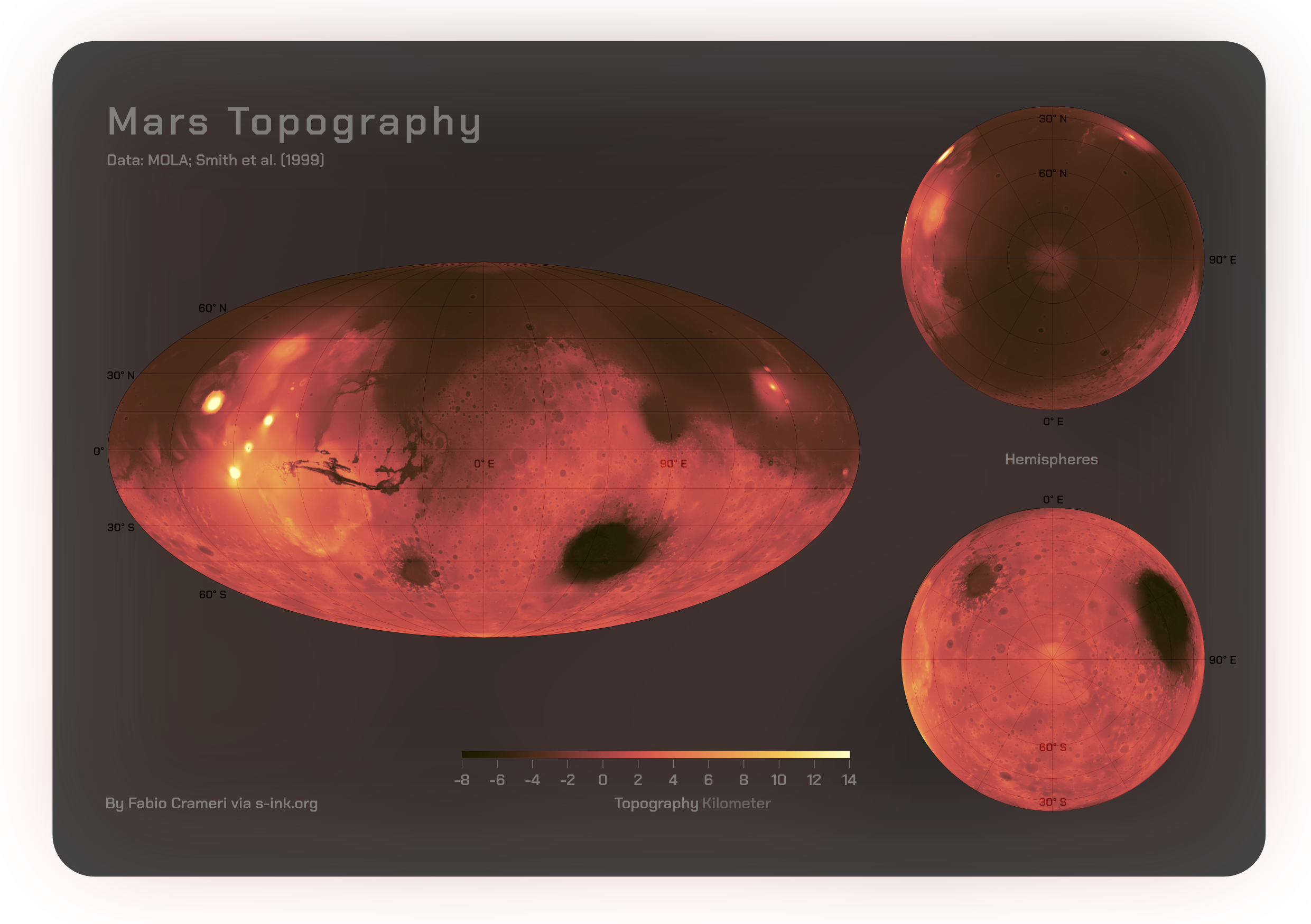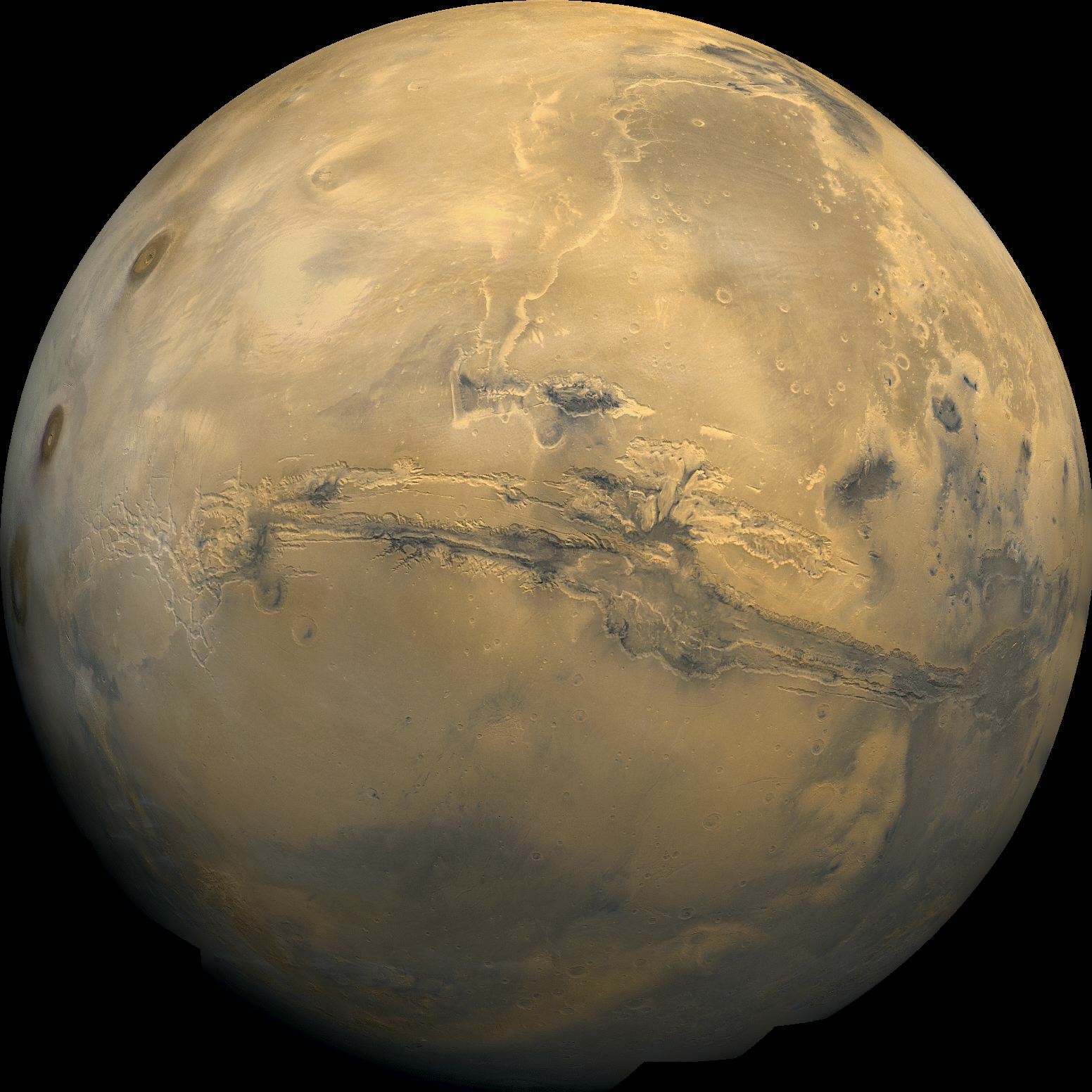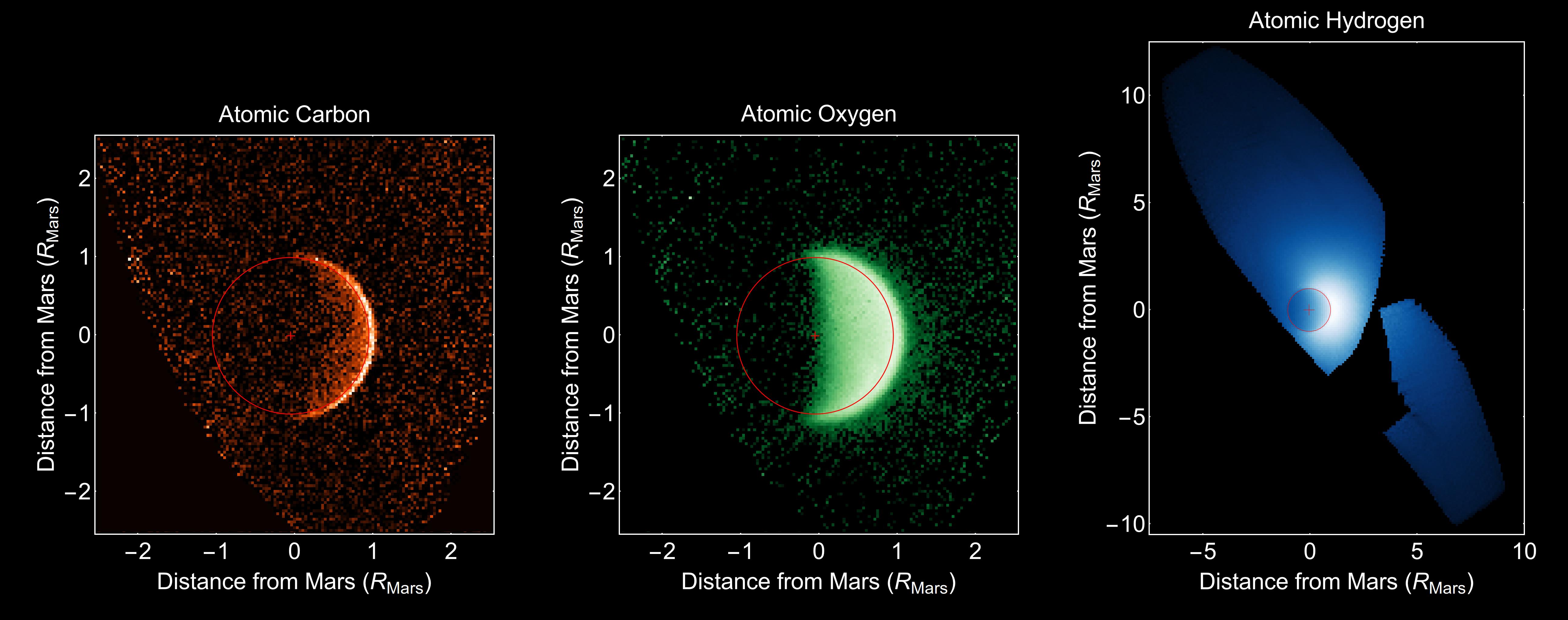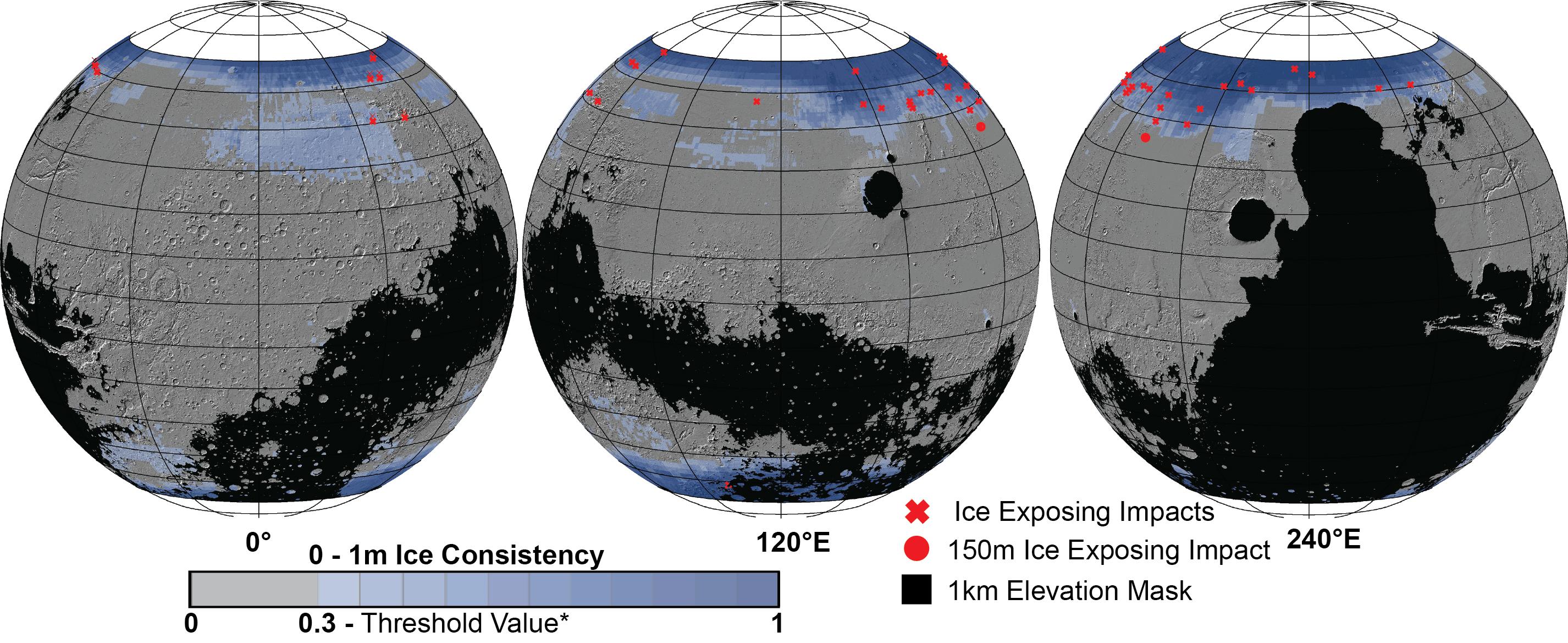Mars: The Red Planet
Mars, the fourth planet from the Sun, is often referred to as the “Red Planet” due to its reddish appearance caused by iron oxide1 dust covering its surface. It’s one of the brightest objects in our night sky, making it a popular target for telescopes.
As a terrestrial planet, Mars shares similarities with Earth, having a solid, rocky surface. However, it’s significantly smaller, with a diameter of about 6,779 kilometers.
A Martian day, or sol, is slightly longer than an Earth day, lasting about 24.6 hours. A Martian year is significantly longer, spanning approximately 687 Earth days.
Mars has two small, irregularly shaped moons: Phobos and Deimos. These moons are much smaller than Earth’s Moon and have unique orbits around the planet.

Mars: A Dynamic Red Planet
Mars, often called the Red Planet, is a fascinating world with a rich geological history. Here are some of its key characteristics:
Martian Dichotomy:
- The planet’s surface is divided into two distinct regions:
- Northern Lowlands: Relatively smooth plains, suggesting a history of volcanic activity and possible ancient oceans.
- Southern Highlands: Heavily cratered terrain, indicating an older surface.
Volcanic Activity:
- Mars is home to some of the largest volcanoes in the Solar System, including Olympus Mons, a massive shield volcano towering 21.9 kilometers (13.6 miles) above the Martian surface.
Canyons:
- Valles Marineris, a vast canyon system stretching over 4,000 kilometers (2,500 miles), is one of the largest in the Solar System.
Geological Activity:
- Mars is still geologically active, with marsquakes, dust devils, and cirrus clouds shaping its landscape.
Climate and Atmosphere:
- Mars has a thin atmosphere composed primarily of carbon dioxide.
- Its polar ice caps contain both water ice and carbon dioxide ice.
- The planet experiences significant temperature variations, ranging from freezing cold to relatively warm.
- Its axial tilt, similar to Earth’s, results in distinct seasons.
Exploration and Future:
- Numerous robotic missions have explored Mars, providing valuable insights into its past and present.
- Future missions aim to delve deeper into the planet’s history, search for signs of ancient life, and potentially pave the way for human exploration.
In essence, Mars is a dynamic and complex world, offering a glimpse into the possibilities of planetary evolution and the potential for extraterrestrial life.
Mars: A Geological Timeline
Formation: Approximately 4.5 billion years ago, Mars formed from the accretion of dust and gas in the early solar system.
Noachian Period (4.5 to 3.5 billion years ago):
- Intense Meteor Bombardment: The surface of Mars was heavily scarred by impacts from meteoroids, leaving behind numerous craters.
- Valley Formation and Erosion: Water, possibly in the form of flowing rivers, carved deep valleys and canyons across the Martian landscape.
- Possible Presence of Water Oceans: Evidence suggests that Mars may have once had vast bodies of liquid water, raising the intriguing possibility of past life.
Hesperian Period (3.5 to 3.3-2.9 billion years ago):
- Widespread Volcanic Activity: Massive volcanic eruptions shaped the Martian surface, creating vast lava plains and towering volcanoes like Olympus Mons.
- Outflow Channels: Powerful floods carved immense channels, suggesting periods of catastrophic water release.
Amazonian Period (3.3-2.9 billion years ago to present):
- Wind Erosion: Wind has become the dominant force shaping the Martian surface, creating vast dune fields and other wind-eroded features.
- Dunes and Other Wind-Shaped Features: Wind-blown dust and sand have sculpted the landscape, leaving behind distinctive formations.
The Search for Life: Mars’s geological history, particularly the evidence of past water activity, has fueled speculation about the possibility of past or present life on the planet. Future missions aim to explore Mars in greater detail, searching for signs of ancient microbial life and assessing the planet’s potential for future human habitation.
A Brief History of Mars Exploration
Our fascination with Mars has led to decades of robotic exploration. Here’s a brief overview of key missions:
- Early Missions:
- Mariner 4 (1965): The first spacecraft to successfully flyby Mars, providing the first close-up images of the planet’s surface.
- Mars 2 and 3 (1971): The Soviet Union’s Mars 2 became the first spacecraft to orbit Mars, while Mars 3 made the first successful landing on Mars, though communication was lost shortly after.
- Viking Program (1975-1976):
- Two Viking orbiters and two landers were sent to Mars. The landers took the first color photographs of the Martian surface and conducted experiments to search for signs of life.
- More Recent Missions:
- Mars Pathfinder (1997): This mission included the Sojourner rover, which explored the Martian surface and collected data on the planet’s geology and atmosphere.
- Mars Exploration Rovers (2004-2018): Spirit and Opportunity rovers explored the Martian surface for years, providing valuable insights into the planet’s history of water.
- Mars Science Laboratory (Curiosity) (2012-present): This rover has been exploring Mars, analyzing rocks and soil to learn more about the planet’s habitability.
- Perseverance (2021-present): This rover is currently exploring Mars, collecting rock and soil samples for future return to Earth.
Future Exploration: While human missions to Mars are still in the planning stages, numerous robotic missions are planned for the coming decades. These missions will continue to explore the Red Planet, searching for signs of past life, studying its geology and climate, and preparing for future human exploration.
History of Nature
The Formation of Mars
Mars, the Red Planet, emerged from the swirling disk of gas and dust that surrounded our young Sun. As this protoplanetary disk gradually cooled and condensed, clumps of matter collided and merged, eventually forming the planets, including Mars.
Mars’ Unique Composition:
Mars’s position in the solar system has significantly influenced its chemical composition. Its distance from the Sun meant that it was exposed to less intense solar radiation, allowing for the retention of volatile elements like chlorine, phosphorus, and sulfur. These elements, which were likely pushed outward by the Sun’s powerful solar wind, became more abundant on Mars compared to Earth.
The Red Planet’s Distinctive Features:
Mars’s reddish hue is due to the presence of iron oxide, commonly known as rust. This iron oxide dust covers much of the planet’s surface, giving it its iconic appearance.
The planet’s geological history is marked by volcanic activity, erosion, and the possible presence of liquid water in the distant past. Features like the vast canyon system, Valles Marineris, and the towering volcano Olympus Mons, testify to Mars’ dynamic past.
The Late Heavy Bombardment and Mars
The Late Heavy Bombardment (LHB) is a hypothesized period in the early Solar System, roughly 4.1 to 3.8 billion years ago, when a large number of asteroids and comets bombarded the inner planets, including Mars. This intense period of impacts left its mark on the Martian surface, with numerous craters and basins.
However, recent research has challenged the traditional LHB theory, suggesting that the bombardment may not have been as intense as previously thought. Nevertheless, Mars still bears the scars of ancient impacts, including the massive Borealis Basin, which is one of the largest impact basins in the Solar System. This basin, thought to have formed from a colossal collision with a Pluto-sized object, covers a significant portion of Mars’s northern hemisphere.
The LHB and subsequent impacts played a crucial role in shaping the Martian landscape, influencing its geology, climate, and potential for habitability. By studying the remnants of these ancient impacts, scientists can gain valuable insights into the early history of the Solar System and the conditions that may have existed on Mars billions of years ago.
That’s a fascinating discovery! The idea that Mars once had a ring system adds another layer of complexity to our understanding of the Red Planet’s history.
The 2023 study suggests that a large moon, about 20 times more massive than Phobos, once orbited Mars. This moon may have been disrupted by a massive impact, resulting in the formation of a debris ring around the planet. Over time, this ring gradually coalesced to form the smaller moon Phobos.
This hypothesis is intriguing because it offers a potential explanation for the unusual orbital characteristics of Phobos. It’s also a reminder that our understanding of the solar system is constantly evolving, and new discoveries can reshape our knowledge of planetary formation and evolution.
Although there are other periods in Mars’ geological history, the three main ones are as follows:
Mars’ Geological Timeline
Noachian Period (4.5 to 3.5 billion years ago)
- Intense Cratering: The surface was heavily bombarded by asteroids and comets, leaving numerous impact craters.
- Tharsis Bulge Formation: The Tharsis volcanic province, home to massive volcanoes like Olympus Mons, began to form.
- Evidence of Water: There’s strong evidence of liquid water flowing on the surface, shaping valleys and carving out channels.
Hesperian Period (3.5 to 3.3-2.9 billion years ago)
- Volcanic Activity: Widespread volcanic eruptions created vast lava plains.
- Outflow Channels: Large-scale flooding events carved out extensive outflow channels.
Amazonian Period (3.3-2.9 billion years ago to present)
- Dominance of Wind: Wind erosion became the primary shaping force, creating dunes and other wind-formed features.
- Continued Volcanic Activity: Sporadic volcanic activity continued, with the formation of Olympus Mons and other volcanoes.
- Relatively Few Craters: The surface is less heavily cratered compared to the Noachian and Hesperian periods, indicating a decrease in impact events.
This geological timeline provides a glimpse into the dynamic history of Mars, a planet that once had a warmer, wetter climate and the potential for life.
Right! Mars, while a seemingly desolate planet, is still a geologically active world.
Recent Geological Activity on Mars:
- Athabasca Valles: This region showcases evidence of relatively recent volcanic activity, with lava flows dating back about 200 million years.
- Cerberus Fossae: This area exhibits signs of water activity, including grabens and channels, suggesting volcanic intrusions that occurred less than 20 million years ago.
- Avalanches: The Mars Reconnaissance Orbiter has captured stunning images of avalanches cascading down Martian cliffs, demonstrating ongoing geological processes.
These findings highlight that Mars is not a static planet but rather a dynamic world with ongoing geological activity, making it a fascinating subject of scientific study.
Physical attributes
Key Points about Mars:
- Size and Mass: Smaller and less dense than Earth, with about 15% of Earth’s volume and 11% of its mass.
- Surface Gravity: Approximately 38% of Earth’s gravity.
- Desert Planet: A rocky planet with a dry, desert-like surface.
- Reddish Hue: The reddish color is due to iron oxide (rust) on the surface.
- Diverse Surface Features: Includes towering volcanoes like Olympus Mons, vast canyons like Valles Marineris, and evidence of ancient water flows.
It’s important to note that while Mars is a fascinating planet with many unique features, it’s also a harsh environment with a thin atmosphere, extreme temperature fluctuations, and high levels of radiation. Despite these challenges, it remains a prime target for future exploration and research.
The internal structure
Mars’ Internal Structure
| Layer | Composition | Average Thickness |
|---|---|---|
| Crust | Silicon, oxygen, iron, magnesium, aluminum, calcium, potassium | 42-56 km |
| Mantle | Iron, magnesium, silicon | N/A |
| Core | Iron, nickel | N/A |
Seismic Activity: Mars is a seismically active planet. The InSight lander has detected and recorded over 450 marsquakes, providing valuable insights into the planet’s internal structure and geological processes.
Beneath the planet’s surface lies a rocky layer called the mantle. This layer is responsible for many of the geological features we see, like volcanoes and shifting tectonic plates. The upper part of the Martian mantle is a bit unusual; seismic waves, a type of energy wave, travel slower through it than the surrounding layers.
The mantle is quite rigid down to about 250 kilometers deep, making Mars’s crust much thicker and stiffer than Earth’s. Deeper than that, the mantle becomes more flexible. Interestingly, Mars doesn’t have a layer like Earth’s lower mantle, which helps to keep heat inside. Instead, the Martian mantle transitions into a mineral composition similar to Earth’s transition zone at around 1050 kilometers.
At the very bottom of the mantle, there’s a layer of liquid rock, about 150 to 180 kilometers thick.
Mars has a molten core made mostly of iron and nickel. This core takes up about half of the planet’s radius, measuring around 1650 to 1675 kilometers across. Unlike Earth, Mars doesn’t have a solid inner core. The core is also rich in lighter elements like sulfur, oxygen, carbon, and hydrogen.
Surface geology
Mars is a rocky planet with a surface made up of minerals like silicon, oxygen, and various metals. The surface is mostly composed of volcanic rock called basalt, although some areas have a higher silica content, similar to rocks found on Earth. Regions with lower reflectivity often contain minerals like plagioclase feldspar. In the northern low-lying areas, there are higher concentrations of sheet silicates and silica glass. The southern highlands have some areas with high-calcium pyroxenes. While there are localized deposits of hematite and olivine, much of the surface is covered in a fine layer of iron oxide dust.

While Mars doesn’t have a global magnetic field today, evidence suggests that it did in the past. Parts of the Martian crust are magnetized, indicating that the planet’s magnetic field reversed polarity multiple times. This is similar to the magnetic patterns found on Earth’s ocean floor.
One theory proposes that Mars had plate tectonics billions of years ago, before its magnetic field disappeared. This activity would have been driven by a planetary dynamo, a process that generates magnetic fields.
The Phoenix lander discovered that Martian soil is slightly alkaline and contains essential nutrients like magnesium, sodium, potassium, and chlorine, similar to Earth soil. These nutrients are vital for plant growth. The soil’s pH level is around 7.7, which is considered basic. However, the presence of perchlorate, a salt harmful to humans, complicates the picture. While the soil’s composition offers hope for potential life, the toxic nature of perchlorate poses a significant challenge.
Mars is often marked by dark streaks that frequently appear on steep slopes. These streaks start dark and lighten over time, sometimes spreading over hundreds of meters. Interestingly, they can navigate around obstacles like boulders. While many theories exist, the most accepted explanation involves the removal of a bright dust layer, revealing darker underlying soil. This could be caused by avalanches or dust devils. Other less common theories include the involvement of water or even the growth of organisms.
The radiation levels on Mars’s surface are relatively low, averaging around 0.64 millisieverts per day. This is significantly lower than the radiation exposure during a Mars mission, which can reach 1.84 millisieverts per day. For comparison, astronauts on the International Space Station experience radiation levels of about 0.5 millisieverts per day.
Interestingly, some areas on Mars have even lower radiation levels. Hellas Planitia, for instance, has a surface radiation of only 0.342 millisieverts per day. Certain lava tubes in the region could offer even lower radiation levels, potentially as low as 0.064 millisieverts per day, comparable to radiation exposure during Earth flights.
Geographical characteristics
Johann Heinrich von Mädler and Wilhelm Beer were pioneers in the field of Martian studies, often referred to as areography. Before them, our understanding of Mars was quite limited. They made significant contributions by confirming that most of Mars’s surface features were permanent and by accurately determining its rotation period.
Mädler’s crowning achievement was the first map of Mars, which he created in 1840 by combining a decade’s worth of observations. This map laid the foundation for future Martian exploration and research.
The naming conventions for Martian features are quite interesting!
- Albedo Features: These are large, easily visible features named after characters from classical mythology.
- Large Craters: Craters larger than 50 kilometers are named after deceased scientists, writers, and other individuals who have contributed significantly to the study of Mars.
- Smaller Craters: These craters are named after towns and villages around the world with populations under 100,000.
- Large Valleys: These are often named after the word “Mars” or “star” in various languages.
- Smaller Valleys: These are named after rivers on Earth.
This naming system helps to honor important figures and places, while also providing a clear and organized way to identify and reference the various features on the Red Planet.
While many older names for Martian features, particularly the large albedo features, have been retained, they’ve often been updated to reflect our growing understanding of their nature. For example, “Nix Olympica” (Snows of Olympus) is now known as “Olympus Mons” (Mount Olympus).
When viewed from Earth, Mars appears to have two distinct types of regions:
- Pale Plains: These dusty, sandy plains, rich in reddish iron oxides, were once mistaken for continents and given names like Arabia Terra and Amazonis Planitia.
- Dark Features: These were thought to be seas, hence names like Mare Erythraeum, Mare Sirenum, and Aurorae Sinus. The largest dark feature visible from Earth is Syrtis Major Planum.
The planet’s polar ice caps are also named: the northern cap is Planum Boreum, and the southern cap is Planum Australe.
While Mars’s equator is defined by its rotation, the Prime Meridian, like Earth’s, is an arbitrary reference point. Early astronomers, Mädler and Beer, chose a specific line for their initial Mars maps in 1830.
Later, in 1972, with detailed imagery from the Mariner 9 spacecraft, scientists Merton E. Davies, Harold Masursky, and Gérard de Vaucouleurs refined this definition. They selected a small crater, now named Airy-0, located in the Sinus Meridiani region, as the 0.0° longitude point. This choice ensured continuity with the original selection made by Mädler and Beer.

Mars doesn’t have oceans, so there’s no “sea level” to use as a reference point for elevation. Instead, scientists have defined a zero-elevation surface called the areoid. This is similar to Earth’s geoid.
The areoid is defined as the height where the atmospheric pressure is 610.5 pascals. This pressure level corresponds to the triple point of water, which is the point where water can exist as a solid, liquid, or gas. It’s important to note that this pressure is only about 0.6% of Earth’s sea-level atmospheric pressure.
To effectively map the Martian surface, the United States Geological Survey has divided it into 30 quadrangles. Each quadrangle is named after a classical albedo feature it encompasses. This division allows for detailed mapping and analysis of specific regions.
In recent years, advancements in space exploration have led to even more detailed maps of Mars. In April 2023, The New York Times reported on an updated global map based on images from the Hope spacecraft. Additionally, NASA released a highly detailed global map of Mars on April 16, 2023. These new maps provide valuable insights into the planet’s geology, topography, and history.
Volcanoes
The Tharsis region on Mars is home to several massive volcanoes, including the colossal shield volcano, Olympus Mons. This mountain is truly enormous, stretching over 600 kilometers wide. Its sheer size makes it difficult to pinpoint an exact height, but its local relief—the difference between its base and peak—exceeds 21 kilometers, more than double the height of Mauna Kea measured from its base.

When considering the total elevation change from the plains of Amazonis Planitia to its summit, the figure approaches a staggering 26 kilometers, nearly triple the height of Mount Everest. This makes Olympus Mons either the tallest or second-tallest mountain in the entire Solar System, with only the Rheasilvia peak on the asteroid Vesta possibly surpassing it.
Impact topography
The striking contrast between Mars’s northern lowlands and southern highlands is a key feature of the planet’s geography. One intriguing theory suggests that this dichotomy was caused by a massive impact early in Mars’s history.
If this theory is correct, a colossal object, possibly one-tenth to two-thirds the size of Earth’s Moon, struck the Northern Hemisphere. This impact would have created a crater of immense proportions, roughly the combined size of Europe, Asia, and Australia. Such a crater would dwarf the existing largest impact craters in the Solar System, including Utopia Planitia and the Moon’s South Pole-Aitken basin.
This hypothesized impact would have significantly reshaped the Martian surface, creating the smooth, low-lying plains of the Northern Hemisphere. The evidence for this theory is still being studied, but it offers a compelling explanation for the planet’s dramatic hemispheric divide.
Mars, the Red Planet, bears the scars of its violent past in the form of countless impact craters. Over 43,000 craters with a diameter of 5 kilometers or more have been identified. The largest and most prominent of these is the Hellas Basin, a colossal impact crater stretching 2,300 kilometers across and plunging 7 kilometers deep. Its light albedo makes it easily visible from Earth.
Other significant impact features include the Argyre and Isidis basins, measuring approximately 1,800 and 1,500 kilometers in diameter, respectively.
Mars’s location and smaller mass compared to Earth make it more susceptible to impacts. Its proximity to the asteroid belt increases the likelihood of being struck by debris from that region. Additionally, Mars is more likely to be hit by short-period comets, those with orbits that lie within Jupiter’s orbit.
That’s a fascinating observation! Some Martian craters do indeed exhibit morphological features that hint at the presence of water after the impact event. These features could include:
- Flow-like deposits: These might suggest the movement of water or mud, possibly triggered by the heat generated during the impact.
- Clay minerals: These minerals often form in the presence of water, and their detection within craters could indicate past aqueous activity.
- Sedimentary deposits: Layers of sediment within craters could be evidence of water-related processes, such as erosion or deposition.
By studying these features, scientists can gain valuable insights into Mars’s past climate and the potential for water to have existed on the planet’s surface.
Tectonic locations
Valles Marineris is a truly awe-inspiring geological feature on Mars. It’s a vast canyon system, dwarfing Earth’s Grand Canyon in both length and depth. Stretching over 4,000 kilometers and plunging up to 7 kilometers deep, it’s a testament to the immense geological forces that have shaped the Red Planet.
The formation of Valles Marineris is linked to the Tharsis bulge, a massive volcanic uplift. As Tharsis swelled, the surrounding crust cracked and collapsed, forming the immense canyon system.

Interestingly, recent research suggests that Valles Marineris might be more than just a rift valley. Some scientists propose that it could be a tectonic plate boundary, indicating a more complex geological history than previously thought. This discovery raises the possibility that Mars may have had a more active geological past, with plate tectonics shaping its surface.
Valles Marineris continues to be a subject of intense scientific study, offering valuable clues about the evolution of Mars and the potential for past or present life on the planet.
Holes and caves
That’s fascinating! The discovery of potential cave entrances on Mars, particularly on the flanks of Arsia Mons, opens up exciting possibilities for future exploration. These caves could provide unique and protected environments, shielding from the harsh Martian surface conditions.
The “seven sisters” caves, as they’re collectively known, offer intriguing prospects for scientific research. Their interiors, shielded from harmful radiation and micrometeoroids, could preserve valuable geological and possibly even biological clues about Mars’s past.
Further exploration of these caves could reveal more about the planet’s history, its potential for past or present life, and its suitability for future human habitation.
The Environment
Mars’ Thin Atmosphere: A Pale Shadow of Earth’s
The Loss of a Magnetic Shield
Billions of years ago, Mars, like Earth, was blessed with a protective magnetic field. This shield deflected the harmful solar wind, allowing a thicker atmosphere to flourish. However, around 4 billion years ago, Mars lost this magnetic shield, possibly due to a series of catastrophic asteroid impacts.

The Solar Wind’s Assault
Without the magnetic shield, the solar wind, a constant stream of charged particles from the Sun, began to erode Mars’s atmosphere. These energetic particles stripped away atoms from the outer layer, gradually thinning the atmosphere. This process, observed by spacecraft like Mars Global Surveyor and Mars Express, continues to this day.
A Thin and Cold World
As a result of this atmospheric loss, Mars today is a cold, arid planet with a thin atmosphere. The atmospheric pressure at the surface varies significantly, ranging from a low of 30 Pa on the peak of Olympus Mons to over 1,155 Pa in the depths of Hellas Planitia. On average, the surface pressure is a mere 0.6% of Earth’s atmospheric pressure.
A Different Scale
The scale height of Mars’s atmosphere, which measures how rapidly atmospheric pressure decreases with altitude, is significantly higher than Earth’s. This is due to Mars’s lower gravity. In fact, the atmospheric density at 35 kilometers above Mars’s surface is comparable to that at the same altitude on Earth.
Implications for Life
The thin Martian atmosphere has profound implications for the planet’s climate and habitability. The low atmospheric pressure and cold temperatures make it difficult for liquid water to exist on the surface for extended periods. While past evidence suggests that liquid water once flowed on Mars, the planet’s current conditions are far from Earth-like.
Understanding the reasons for Mars’s atmospheric loss is crucial for piecing together the history of this once potentially habitable world. It also provides valuable insights into the factors that contribute to planetary habitability and the potential for life beyond Earth.
Mars’ atmosphere is primarily composed of carbon dioxide, with smaller amounts of argon and nitrogen. It also contains trace amounts of oxygen and water vapor. The Martian atmosphere is quite dusty, with fine particles giving the sky a distinctive tawny color when viewed from the surface. Additionally, the presence of iron oxide particles can impart a pinkish hue.
One intriguing aspect of the Martian atmosphere is the fluctuating levels of methane. Methane is a greenhouse gas that can be produced by both geological and biological processes. While geological processes like serpentinization can generate methane, its presence on Mars could also indicate the existence of microbial life. However, more research is needed to definitively determine the source of Martian methane.
Understanding the composition and dynamics of Mars’ atmosphere is crucial for unraveling the planet’s history, assessing its habitability potential, and planning future human exploration missions.
The unique atmospheric conditions on Mars significantly affect the propagation of sound compared to Earth. Here’s a breakdown of the key factors:

1. Thin Atmosphere:
- Mars’ atmosphere is much thinner than Earth’s, with a lower atmospheric pressure. This results in a less dense medium for sound waves to travel through.
- The lower density reduces the efficiency of sound transmission, leading to more rapid attenuation.
2. Higher CO2 Concentration:
- The high concentration of carbon dioxide in Mars’ atmosphere can influence the speed of sound, particularly at lower frequencies.
- The molecular weight of CO2 is higher than that of the primary components of Earth’s atmosphere (nitrogen and oxygen), which can affect the speed of sound propagation.
3. Lower Surface Pressure:
- The lower surface pressure on Mars further contributes to the attenuation of sound waves.
- Sound waves require a certain level of pressure to propagate effectively. The lower pressure on Mars limits the distance sound can travel before dissipating.
4. Speed of Sound:
- Research from the Perseverance rover has revealed that the speed of sound on Mars is slower than on Earth, especially at lower frequencies.
- This difference in sound speed can impact the way sound is perceived and the types of sounds that can be heard on Mars.
5. Limited Natural Sound Sources:
- Unlike Earth, Mars has a relatively quiet environment. The lack of significant natural sound sources, such as oceans, rivers, and abundant wildlife, further emphasizes the distinct acoustic characteristics of the Red Planet.
These factors combine to create a unique acoustic environment on Mars, where sound behaves differently than it does on Earth. Understanding these differences is crucial for future missions to Mars, as it can influence the design of communication systems and the exploration of the planet’s surface.
That’s a fascinating aspect of Mars! While we often associate auroras with Earth’s polar regions, Mars presents a unique scenario. Due to the absence of a global magnetic field, Martian auroras can occur anywhere on the planet, not just at the poles.
The solar wind, a stream of charged particles from the Sun, directly interacts with Mars’s atmosphere, leading to the formation of these auroras. In 2017, a powerful solar storm resulted in a massive aurora on Mars, significantly increasing radiation levels on the planet’s surface.
Understanding these Martian auroras provides valuable insights into the interaction between the solar wind and planetary atmospheres, as well as the potential hazards for future human exploration of Mars.
The Climate
Mars experiences distinct seasons, much like Earth, but with a significant twist due to its elliptical orbit. When Mars is closest to the Sun (perihelion), its southern hemisphere experiences summer, leading to more extreme temperatures. Conversely, when Mars is farthest from the Sun (aphelion), its northern hemisphere experiences summer, resulting in milder conditions.
This orbital eccentricity amplifies the seasonal differences between the two hemispheres. Summers in the southern hemisphere can be up to 30 degrees Celsius warmer than summers in the northern hemisphere. This phenomenon highlights the unique climatic conditions on Mars, shaped by its orbital characteristics and thin atmosphere.
Mars experiences a wide range of temperatures due to several factors:
- Thin Atmosphere: Mars’s thin atmosphere cannot retain heat effectively, leading to significant temperature fluctuations between day and night.
- Low Atmospheric Pressure: The low pressure further exacerbates the heat retention problem, causing rapid temperature drops.
- Low Thermal Inertia of Soil: Martian soil heats up quickly during the day but cools down just as rapidly at night.
- Distance from the Sun: Being farther from the Sun than Earth, Mars receives less solar radiation, contributing to its colder temperatures.
As a result, Mars can experience extreme temperature swings, with daytime highs reaching up to 35°C (95°F) at the equator and nighttime lows plummeting to -110°C (-166°F) at the poles.
Mars is renowned for its colossal dust storms, which are the largest in the entire Solar System. These storms can reach wind speeds exceeding 160 km/h (100 mph) and range from localized events to planet-enveloping phenomena.
Interestingly, these storms tend to occur when Mars is closest to the Sun. As the planet warms, the atmosphere becomes more turbulent, lifting vast amounts of dust into the air. These dust particles absorb sunlight, heating the atmosphere and further intensifying the storm.

The impact of these global dust storms is far-reaching. They can obscure the Martian surface, making it difficult for spacecraft to observe the planet. Additionally, they can significantly alter the Martian climate, both warming the atmosphere and cooling the surface.
Despite their disruptive nature, these dust storms offer valuable insights into the Martian climate system and the planet’s geological history. By studying these events, scientists can better understand the complex interplay between the atmosphere, surface, and subsurface of Mars.
Additionally, the seasons create dry ice that covers the polar ice caps. Huge portions of Mars’ polar regions
Hydrology
That’s right! A significant portion of Mars’ water is locked up in the form of ice at its poles. The southern polar ice cap, in particular, contains a substantial amount of water ice. If melted, this ice could cover much of the Martian surface with a layer of water several meters deep.
This discovery has significant implications for our understanding of Mars’ past and future. It suggests that Mars once had a much warmer and wetter climate, and it raises the possibility of future human exploration and colonization.

While there’s evidence of water ice and even past flowing water on Mars, liquid water cannot persist on the surface for extended periods due to the planet’s low atmospheric pressure. This low pressure causes water to rapidly evaporate or sublimate, transitioning directly from a solid to a gas state.
However, in certain specific conditions, such as in deep valleys or during periods of higher atmospheric pressure, liquid water might be able to exist temporarily on the surface. This highlights the complex and dynamic nature of the Martian environment.
That’s right! While the Martian atmosphere is quite thin, it does contain small amounts of water vapor. This water vapor can condense and form clouds of water ice. Under specific conditions, these clouds can produce snowfall, often mixed with carbon dioxide ice.
These icy deposits are significant for understanding Mars’ climate history and the potential for past or present life. They also provide valuable insights into the planet’s water cycle and the role of atmospheric processes in shaping the Martian landscape.
Beyond the hydrosphere
The presence of outflow channels on Mars is strong evidence that liquid water once flowed on its surface. These massive, linear features, some stretching hundreds of kilometers, are thought to have been carved by catastrophic floods that released vast amounts of water from subsurface aquifers.

One of the most prominent examples is Ma’adim Vallis, a colossal channel significantly larger than Earth’s Grand Canyon. This feature provides compelling evidence for a watery past, suggesting that Mars once had a more temperate climate capable of supporting liquid water.
It’s important to note that while some scientists propose alternative explanations for the formation of these channels, such as glacial or volcanic activity, the prevailing theory remains that they were carved by powerful floods. This understanding has profound implications for our understanding of Mars’s history and its potential for past life.
The presence of dendritic valley networks on Mars is another strong indicator of past surface water activity. These networks, resembling river systems on Earth, suggest that significant rainfall once occurred on Mars. While subsurface water flow and groundwater sapping might have played a role in shaping some of these valleys, the overall pattern and distribution point to precipitation as the primary driver of erosion.

These findings provide further evidence that Mars once had a much warmer and wetter climate, capable of sustaining liquid water on its surface. Understanding the conditions that allowed for these ancient river systems is crucial for unraveling the history of Mars and its potential for past life.
The presence of gully features on Mars is a fascinating aspect of the planet’s geological history. These features, often found on crater walls and canyon slopes, bear a striking resemblance to terrestrial gullies, suggesting the involvement of liquid water in their formation.
While some scientists propose that these gullies could have formed through processes involving carbon dioxide frost or dry dust movement, the prevailing theory involves the melting of subsurface ice. This hypothesis is supported by the young age of the gullies and the lack of significant weathering or impact craters on them.
Additionally, the discovery of deltas and alluvial fans preserved within craters provides further evidence for past water activity on Mars. These features suggest the presence of crater lakes, which would have required a warmer and wetter climate to form and sustain.
The detection of minerals like hematite and goethite, which often form in the presence of water, further strengthens the case for a wet Martian past. These findings offer valuable clues about the planet’s climate history and the potential for past or present life.
History of water evidence observations and discoveries
The discovery of minerals like jarosite, silica, and gypsum on Mars provides strong evidence for the past presence of liquid water on the planet. Additionally, the detection of hydroxyl ions in Martian minerals suggests that a significant amount of water may be locked within the planet’s upper mantle. This water could potentially cover the entire planet to a depth of hundreds of meters if released.
The Curiosity rover’s discoveries have significantly expanded our understanding of Mars’s watery past. The detection of hydrated minerals like calcium sulfate and the presence of subsurface water indicate that Mars once had conditions conducive to the existence of liquid water.
The recurring slope lineae, mysterious dark streaks that appear on Martian slopes during warmer seasons, have been a subject of intense scientific debate. While initial observations suggested the involvement of briny flows, later research has raised questions about the role of water in their formation.
Despite these uncertainties, the evidence for past water activity on Mars is compelling. The discovery of ancient river valleys, lakebeds, and mineral deposits that form in the presence of water paints a picture of a once-wet and potentially habitable planet.
The possibility of an ancient ocean on Mars is a fascinating topic that continues to be debated by scientists. While some evidence, such as the high deuterium-to-hydrogen ratio in the Martian atmosphere, suggests the existence of a vast ocean in the past, other researchers remain cautious.
The discovery of a large water ice deposit in Korolev Crater provides further evidence for Mars’s watery past. However, the specific conditions that would have allowed for the formation and persistence of a global ocean on Mars are still not fully understood.
As research continues, we may gain a clearer picture of Mars’s climate history and the potential for past habitability.
Recent discoveries have revealed significant amounts of water ice on Mars. In 2016, NASA reported finding a large deposit of underground ice in the Utopia Planitia region, estimated to be equivalent to the volume of Lake Superior. Additionally, the ExoMars Trace Gas Orbiter detected indications of subsurface water ice in the Valles Marineris canyon system during observations from 2018 to 2021.
To be continued in the Next Part
Latest Updates







 Let’s imagine, explore, and uncover the mysteries together!
Let’s imagine, explore, and uncover the mysteries together!